[Wedge Pattern] - Crypto Academy / S5W5 - Homework Post for @sachin08

1. Explain Wedge Pattern in your own word.

The Wedge Pattern is one of the patterns that traders will analyse on cryptocurrency charts with death penalty methods and do technical analysis before the death penalty.
This pattern is built on chart supported price movement indicating that the market is trending and close to specialized in a trend reversal.
The price movement shows a convergence that widens the road formed in the beginning and continues to thin. This pattern is created by traders by drawing trend line support and resistance lines that combine multiple points of supported price movements in bound trends.
The wedge pattern is analysed by the dealer during a very limited time frame of your time wherever the cryptocurrency market is in an uptrend or downtrend by forming a line.
Higher trend line is formed by joining several resistance points reached by price movement during a trend hence it is known as resistance line.
The lower trend line is formed by joining several support points that the price movement has reached during a trend hence it is known as a support line.
This pattern is relied upon by traders to check market trends that show trend continuation or trend reversal which can be used to confirm options and as a connection to next steps within professionalism.
In this case, the wedge pattern will signal to traders a trend reversal that will occur when the market is aware of a jail break, so traders will receive or sell orders at the right time.
If this pattern is fashioned in an uptrend and indicates a trend reversal, the dealer will place a sell order at the beginning of the downtrend when the market breaks out.
Conversely, if this pattern is formed in a very downtrend and indicates a trend reversal, the dealer will place a get order at the beginning of an uptrend when the market breaks.
This can be done by traders to execute trades that can bring in profits and eliminate losses.

2. Explain both types of Wedges and How to identify them in detail. (Screenshots required)

rising wedge pattern :-
A rising wedge can be a chart pattern indicating a pessimistic outcome. It is easy to accept that price moves between the convergence of support and resistance lines towards an objective.
Worth associates are going to travel in an uptrend and when it breaks the support line, it will be the start of a pessimistic trend. Price moving between the patterns suggests that the bulls square measure losing the market and bears management may currently take over the facility.
There are several things to consider while characterizing this pattern. The primary issue is that a pair of lines that serve as support and resistance are sloping to the upside.
The value must be bitten five times for each trend line to be valid. The amount of assistance for a potential goal break should be considered jointly. I have actually attached a screenshot of Associate in Nursing example for higher understanding.
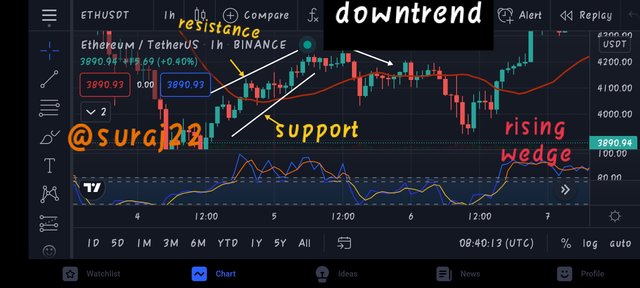
screen shot by trading view app
Falling Wedge Pattern:-
The falling wedge is the exact opposite of the rising wedge pattern. This indicates an optimistic price although the asset had to make an initial exit from the support line.
It is recognised by the consolidation between a pair of decreasing lines. However, there is square measure some parts to consider while characterizing the pattern.
The most essential half is that of a pair of lines that serve as support and resistance for the price.
It tends to consolidate between a pair of lines and must be at least five times the value. A trader must simultaneously take a look at the amount in order to find out a lot about the action.
You will notice that the chart pattern below for BTC/USDT is a classic example of a falling wedge pattern.
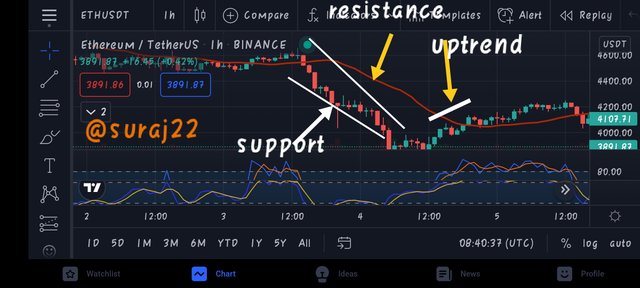 screen shot by trading view app
screen shot by trading view app

3. Do the breakout of these Wedge Patterns produce False Signals sometimes? If yes, then Explain how to filter out these False signals.

Yes, usually avoiding wedge patterns gives false signals, as no pattern or indicator gives 100% correct predictions or results.
Fortunately, there are a few solutions we'll use to isolate these false escape signals, and my contribution below.
First, we will isolate these false signals when we see a price reversal rather than an immediate price move when an escape has occurred. Thus, a trend reversal must occur before we can escape or warrant the reality of the pattern.
Another way to spot these false signals is that if the connection is one of the escapes within the trend line, a false escape will usually surface before the connection is specifically escaped between the trend line, which misleads traders.
Thus we should always pay attention to the circumstances. Price should not break above or below the trend line until the ultimate escape objective, which ends in a trend reversal.
Also, once we stumble upon a divergence from the trend line, we will get these false signals. As an example, a rising wedge should be shaped at the top of an optimistic trend line and a downward break of the support trend line, although not a partner in nursing an upward break of the resistance trend line, thus would be a false escape signal if The price breaks the resistance trend line instead of the support trend line .
Simply put, in nursing, an uptrend from a rising wedge and a downward move of a falling wedge indicates a false escape signal, thus we should always avoid such a breakout as it will result in us taking a lost position.
We can use the indicators in the charts similarly to differentiate these false escape signals. Indicators like Moving Average Convergence Divergence (MACD), Relative Strength Index (RSI), Average True Variety (ATR) etc. cannot differentiate such false signals.
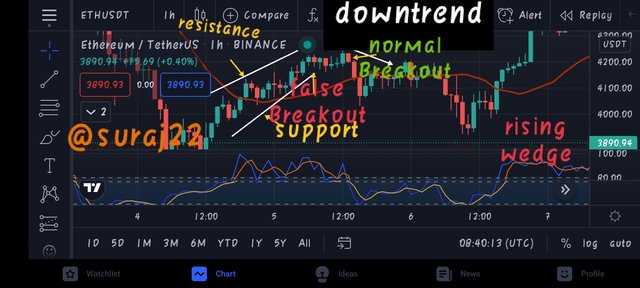 screen shot by trading view app
screen shot by trading view app
The top of the STEEMUSDT combination chart is an example of a false escape signal during the Associated Rising Wedge in Nursing, and therefore confirmed by the RSI indicator.
The rising wedge pattern misled traders by nursing an uptrend escape, meanwhile when a brief amount, the price fell back within the trend line and reversed into a downtrend that made the initial escape a false escape.
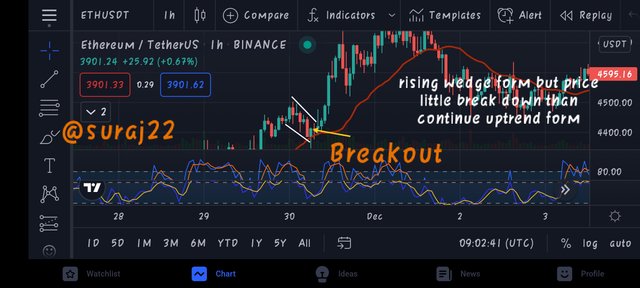 screen shot by trading view app
screen shot by trading view app
Another example of a false escape signal during a rising wedge is the consolidation of the chart at the top of STEEMBTC causing price action to return to the initially stone-broken resistance trendline, Wedge and instead of an eventual escape. instead of touched in one go. Reversing the immediate bearish trend.

4. Show full trade setup using this pattern for both types of Wedges.( Entry Point, Take Profit, Stop Loss, Breakout)

Trade Setup for Rising Wedge
A sell entry setup sometimes occurs within a rising wedge. This often results in movement when the ally is sometimes in an upward direction before fleeing and the escape makes room for a downward movement or pessimistic trend.
A sell entry is sometimes set up once the trend is in a downward direction. Thus let's take a look at the sales entry setup chart below.
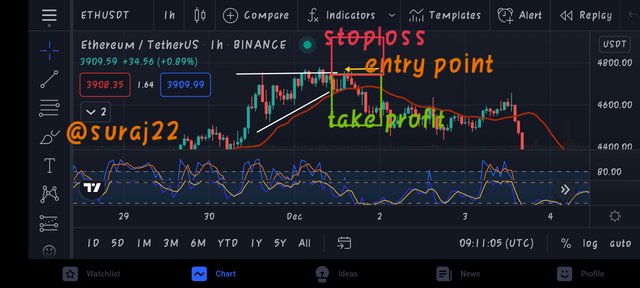 screen shot by trading view app
screen shot by trading view app
The chart above contains everything that is needed to replace the moving wedge. As you can see from the chart, we have each of our trend lines.
we have marked our escape positions and our entry positions in the same way. Stoploss is also considered as take profit level. The chart also shows the degree of quality occupation in descending order.
Trade setup for falling wedge
A GET entry setup sometimes occurs within a falling wedge. This often results in movement when the escape is sometimes in an extreme downward direction and the escape also makes room for an upward movement or bullish trend. A one-time entry is sometimes set once the trend business associates in the upward direction. So let's take a look at the entry setup chart below.
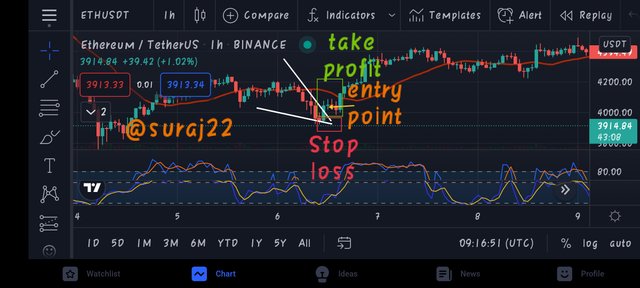
screen shot by trading view app
The chart above has everything needed to replace a falling wedge. As you can see from the chart, we have each of our trend lines, we have marked our escape positions and our entry positions in the same way. Stoploss is also considered as take profit level. The chart also shows the degree of quality occupation in descending order.

Conclusion
I think the wedge pattern is one of the most important perfect patterns in trading because the fact is that on break it doesn't always reach its target as fast as the other patterns.
I think the wedge pattern should be a sensible chart pattern which traders should look for as it involves a high probability of success once it is eventually broken out, but at the same time traders should research a chart pattern very quickly and deterministically before it hits an edge Whether or not the signal area units are in confluence with each other may or may not help ensure that this pattern plays out nicely.
